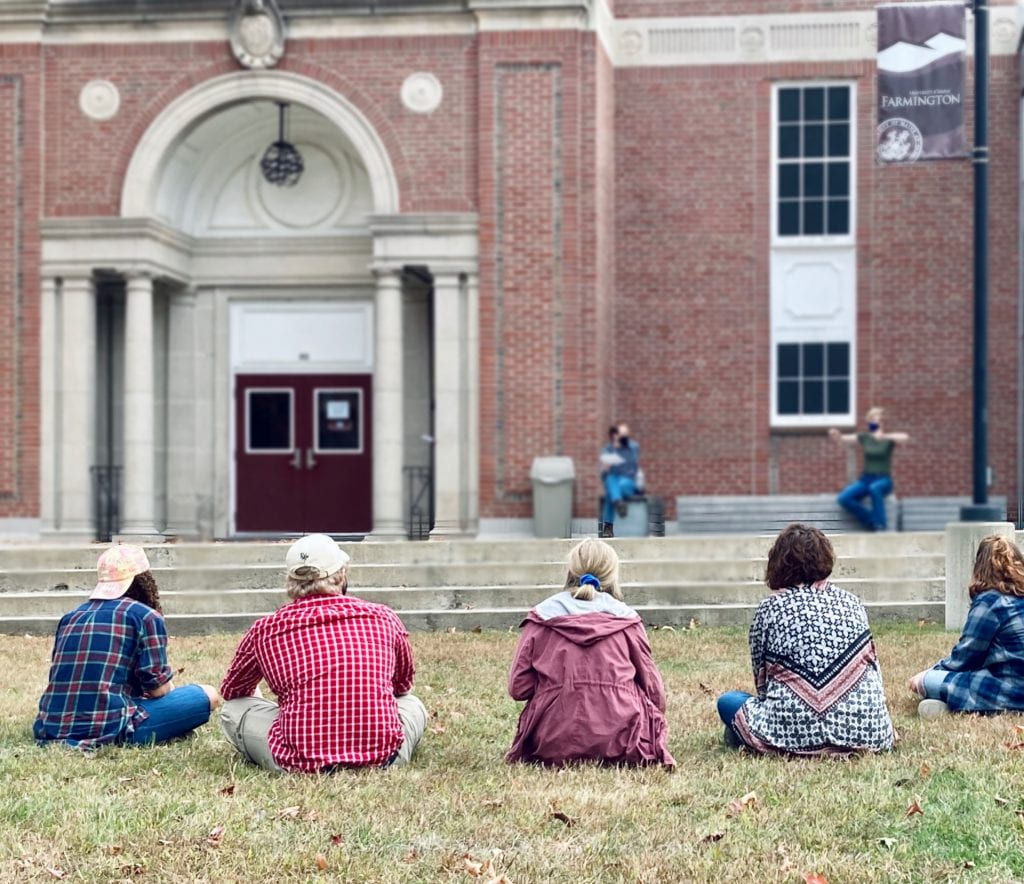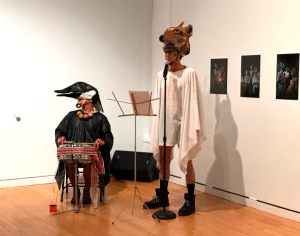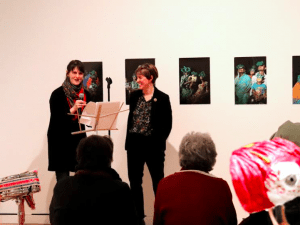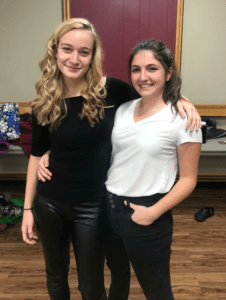
Nov 12, 2020 | Feature |
by Ciera Miller, Staff Writer

Audience members watching Spilecki Spaloosa behind Merrill Hall. (Photo courtesy of Ciera Miller)
On Oct. 10, the National Theatre Honors Society (NTHS) and Alpha Psi Omega (APO) at UMF hosted their first Spilecki Spaloosa in the Emery Courtyard behind Merrill Hall.
APO consists of students who were specially chosen due to their avid participation in theatre on campus. They live and breathe in the theatre world, and they plan events to share that love with others.
Matty Bernard, president of APO, said, “The Spilecki Spaloosa was written in part by former UMF APO members many years ago, but was never performed until now.” Although the idea had been kicking around for so long, the current APO members still needed a little push to make it into an actual event. “The Spaloosa is named after Stan Spilecki, the technical director at UMF, because of his involvement and encouragement towards APO to do this. He had done a similar event in the past where it was treated like a competition,” Bernard said.
This year’s Spilecki Spaloosa wasn’t a competition, but it was simple in practice; any interested UMF student could participate, and they chose whether they wanted to act or to watch. If students wanted to act, their name went into a pink pumpkin head. From this pumpkin head, Bernard chose random names for a random 10 minute scene that one of the APO members was going to direct. Both the director and actors had never seen the script before, making the challenge even harder.
“You don’t know what you’re doing,” said Sam Wood, one of the APO members, who was directing the scene. “You just skip the scenes you don’t like―or you try to.” Although she didn’t like some of the content she was staging, Wood wasn’t completely upset with the directing process. “It was fun! You get to work with people you don’t usually get to work with,” she said. Eli Mowry, APO member and president of Student Theatre UMF (STUMF), voiced similar sentiments.
The impromptu actors were excited about the performances. They were given ten minutes to rehearse their scenes before going in front of a live audience. Emalyn Remington, secretary of STUMF, called it a magical and fulfilling experience. “It was hard trying not to laugh,” Remington said, in response to her fellow actor making chimpanzee noises in the middle of their scene. Another actor, Paul Riddell, put it more simply: “In a word―fun.” Riddell also discussed having this event in the COVID-19 era. “The two main challenging things during COVID-19 are projecting [your voice] through the mask and keeping six feet apart,” Riddell said.
Both APO and STUMF have been trying to keep up with COVID-19 regulations while still having theatre events on campus. They’re trying their best to enforce the six feet apart rule, having everyone wear their masks, and being safe while performing. “Theatre has been very difficult in the current climate, so it’s just good for us to be here,” Mowry said. “I’m glad that people are here at STUMF meetings, at APO events, doing the Spaloosa.”
While being socially distanced can make things harder, the Spilecki Spaloosa was fun for everyone involved―directors, actors, and audience members. Elly Bernard, part of the audience, said she thought it was very creative and very entertaining. The scenes were performed wonderfully despite their short rehearsal time, laughs echoed throughout the night, and everyone left with smiles on their faces. They all agreed that it had been an enjoyable night. “And that’s what theatre’s about,” Mowry said. “Having fun.”
“I think that the event could be done in the future,” Matty Bernard said about more spaloosas. “We can normally open the event up to the entire UMF community, but because of COVID-19 restrictions, we were not able to do so [this time].”
So if you missed the Spilecki Spaloosa this time around, keep your eyes peeled for future spaloosas and theatre events hosted by APO. If you want to join a theatre club, Student Theatre UMF (STUMF) meets every Friday at 5:10 PM in the Emery Courtyard behind the Merrill Center and invites anyone interested in theatre to join.

Feb 28, 2020 | News |
Taylor Burke, Contributing Writer
The VOYAGER: Migrational Narratives exhibit introduces a conversation on migration to the UMF community through various mediums and perspectives. The exhibit, which is free to the public, opened from Jan. 30 to March 6.
Olivia Donaldson and Ann Bartges, curators of the exhibit, recently opened the gallery on a night that included live performances and virtual reality experiences. The exhibit features paintings, collages, photographs, textiles, sculptures, a poem and digital media pieces that viewers can watch and listen to. Each piece explores what it means to migrate and highlights experiences and perspectives on migration.
Donaldson, a French professor, has been researching migration and teaches global studies. She is passionate about migration and interested in the arts. Bartges is the director of the Emery Community Arts Center and a professor of visual arts.
Donaldson and Bartges were friends prior to the project which aided their collaboration. They began conversing about migration over a poem that became part of the exhibit. “In some ways, the poet launched the conversation between Olivia and I a long time ago,” Bartges said, “the poem kind of started the whole idea of the exhibition.” Bartges proposed the idea of the exhibit to Donaldson in her efforts to find ways that Emery could serve the rest of the campus, not just the art department.
The whole project took about a year to complete. “I don’t know if either of us really mapped that out when we started this,” Bartges said laughing with Donaldson. With Bartges’ background in art and Donaldson’s vision for interdisciplinary work, the two complemented each other in the curation process.

Arturo Herrera (left) and David Sanders (right) perform at the opening night for the VOYAGER exhibit. Photo Courtesy of Ann Bartges.
Donaldson and Bartges put out a call for submissions and were presented with a strong pool of pieces. “The works by artists who had experienced migration first hand had so much more depth,” said Bartges. “Those works just tended to have more layers,” she said.
Bartges and Donaldson’s decisions were influenced by their vision for the exhibit and tone they wanted to set. “We really didn’t want the show to become a binary conversation about whether migration is good or bad,” Donaldson said. “We wanted the show to be about connections.”
Bartges found Nayda Cuevas’ piece, “Adios: Puerto Ricans Always in Migration” to capture the tone they wanted for the exhibit. “We wanted to show this really human part of the migration experience,” she said.
This exhibit provides another perspective to understanding migration and its many facets. “We all engage with [migration] in newspaper headlines and in political language,” Bartges said. “But then there’s this other opportunity to engage in these issues through stories and narratives and experiences.”
One of the mediums, included only on opening night, was a virtual reality film called “A Shared Space: Lewiston,” created by documentary filmmaker Daniel Quintanilla and collaborators Shuab Mahat and Hilowle Aden. The film chronicles Mahat and Aden, two friends, who grew up in the Dadaab Refugee Camp in Eastern Kenya and currently live in Lewiston. “It looks at the challenges they each face in raising families in Maine during a time of rising nationalism, closed borders and travel bans,” Quintanilla said in an email.
The virtual reality experience allows viewers to immerse themselves in the content in ways other forms don’t allow for. “[A Shared Space: Lewiston] came out of a need to create content that could help others see and imagine the lives of others,” Quintanilla said.“We saw 360-degree cameras and headsets as a way to create virtual experiences in which we could invite viewers to enter spaces they might not be able to enter on their own.”
The creators of the film wanted to call attention to Maine’s connection with migration and the issues that surround it.“It’s too easy to be passive and think that families separated by ICE, borders, or policies is happening elsewhere,” Quintanilla said. “One of our goals is to highlight Maine’s relationship to global migration.”
This piece, like all of the others in the exhibit, is a way of storytelling and communicating human experiences. “I hope viewers are not only moved by the stories presented,” Quintanilla said in an email. “But can translate that empathy into action of some kind.”
Two of the pieces in the exhibit were created by creative writing professor, Éireann Lorsung. Her first work, “Completely out of Water,” is a collage piece from a series of 15 that she made during her time in Belgium.
Lorsung used this piece to play with English idioms while also channeling her own experience of being foreign. “What happens when you make an idiom literal?” she said. “What’s literally happening is very uncomfortable.” Although the literal meanings of idioms can cause discomfort, the piece was also supposed to evoke some humor due to the differences between the literal and metaphorical meanings of idioms.

Curators Ann Bartges and Olivia Donaldson speak at the opening night of the VOYAGER exhibit. Photo Courtesy of Ann Bartges.
Lorsung’s second piece, “Royaume de lumière x 144,” is part of a series of 144 small paintings that document the land that she lived on and had to leave. There is also a sound bit that goes along with the piece and plays a recording of the sounds from her garden.
When Lorsung left Belgium she lost her sheep and garden, among other things. “There’s no clear way to live through that,” Lorgsung said. “Art is a way that I’m trying to understand all that stuff.”
All the objects in the paintings are drawn from memory in an effort to reclaim what can’t be reclaimed. “Basically all the work I do is really thinking about having been an immigrant and what it meant to leave,” she said.
As an immigrant herself, Lorsung has noticed that migration is generally demeaning despite it being a natural and historical occurrence. “It’s borders and boundaries that are the new thing,” she said. “Human migration is not a new thing.”
Arturo Herrera, who is based in the Detroit area, was the creator of “The National Bird” piece displayed at the exhibit. “The National Bird is an experimental performance series highlighting several migratory animal disguises,” Herrera said in an email. “It builds on the premise that wild creatures can legally cross territorial boundaries anytime and anywhere without checkpoints.”
“The National Bird” gave and still gives Herrera the opportunity to create work that tells his personal story while not being directly about him. The piece is not finished and continues to evolve and grow, much like the subject of migration. “The work provides a different perspective on issues of relevant concern like immigration,” he said.
Herrera attended the opening night of the show and performed using two characters from his series. “[M]y impression was great of the show, as well as how every work in the gallery was speaking with each other,” he said in an email.

Nov 21, 2019 | News |
Jocea Jordan Contributing Writer
Practicing 10 hours or more a week, UMF’s Bust-A-Move Beavers (BAM) dance group members are working hard to make their end-of-semester performance a memorable one.
BAM is one of two UMF dance groups and they hold two performances every year. Each performance is held at the end of the semester with three different show times. The dancers choreograph all 25 of the dances on their own, and even have a show reserved specifically for their parents and families.
Carson Hope, a senior early childhood special education major, is the treasurer of BAM and has been in a previous semester as well. Hope is responsible for the finances of the club and makes all of the costume purchases, fundraiser orders, and proposes the budget BAM will need for the year.
Hope has been a member of BAM for five semesters now and has made many close friends throughout her time in the club. “BAM has really brought me all of my closest friends that I have here in Farmington,” she said. “So I just have a great collection of memories of dancing with the people that I get to call my closest friends now.”
“I have danced on and off my entire life, I started dancing when I was five or six but I took several years off because I did gymnastics growing up too, and I got back into dance my freshman year here,” Hope said. “Dancing in BAM has given me a way to express myself, and to be able to have an artistic outlet, so that I can express my myself in a way that words don’t.”
“When I came here my freshman year I did not have a lot to do, but now I have this thing [BAM] that is a priority in my life, and plays an important role,” she continued.

Sierra Huff dressed as Sandy and Portia Hardy dressed as Danny from Grease the movie (Photo courtesy of Sierra Huff)
“We typically fill Emery for all of our shows, sometimes the Wednesday show doesn’t fill up, but for our Friday and Saturday shows we have people getting in line at 5:00 p.m. and 5:30 p.m. to get a seat for the 7:00 p.m. show,” said Hope. “We typically have people that are turned away at the door. If we had a bigger space that would be great, but we don’t.”
Sierra Huff, a sophomore biology pre-med major, has been a part of BAM for three semesters now and is going to be in six dances for this semester’s performance. Huff’s favorite part of being a dance member in BAM is “meeting the new people I wouldn’t have a chance to interact with otherwise.”
“I would say the most challenging part is making sure you dedicate time to practice for each dance,” said Huff. Most of the dances that the members are in only have practice for one hour a week. “A lot of the time just the one hour rehearsal is not enough to memorize the dance if you are in close to 10 of them,” Huff said.
For bigger dances, in which most of the members are involved, there are longer practices held each week. Huff enjoys these practices and said, “It is always interesting when we cannot use the North Dining Hall because it is unavailable, so we have to practice in a Roberts classroom.” She continued on, laughing, “So we have roughly thirty people trying to move and dance together in a tiny room.”
BAM also hosts a costume contest for its members during their practice on Halloween. “It is always interesting to see what costumes the other dancers come up with,” said Huff. “This year I went as a vampire with another member of BAM. Last year I went as Sandy, and my friend Portia went as Danny, which are the main characters from ‘Grease’ the movie.”
“I also enjoy some of the other fun events that we do like Secret Santa, where members give a gift to another member that they randomly picked,” said Huff. “And the end of the semester banquet where we give out our secret santa gifts and everyone brings different food and drinks for us to enjoy together.”
Portia Hardy, a sophomore Earth and Environmental Science major with a minor in editing and publishing, has been a member of BAM for three semesters. She began dancing when she was three and a half years old at the Kennebec Dance Studio. “I really like taking part in the performance and being on stage in front of the audience, getting to be in the show makes me really happy,” she said.
“Last spring semester I choreographed a dance with my friend Matt, it was to ‘A Lovely Night’ from ‘La La Land’ and it was a really cute, fun, sweet duet,” said Hardy. “It was my favorite moment being on stage. The last show that [Matt and I] did we both smiled at each other because it was our last one together… there have been so many good memories.”
“This semester I’m doing the smallest amount of dances that I have done, I’m only in three. Last spring semester I was in six and that was the highest that I have done,” said Hardy. “Some people do like eight dances, ten dances. They really like to dance. I personally can not fit a lot into my schedule but I know that others can.”
The showtimes for BAM’s performances are on Dec. 4-7 at 7 p.m. in the Emery Community Arts Center. The doors will open at 6:30 p.m. for all of the shows.




